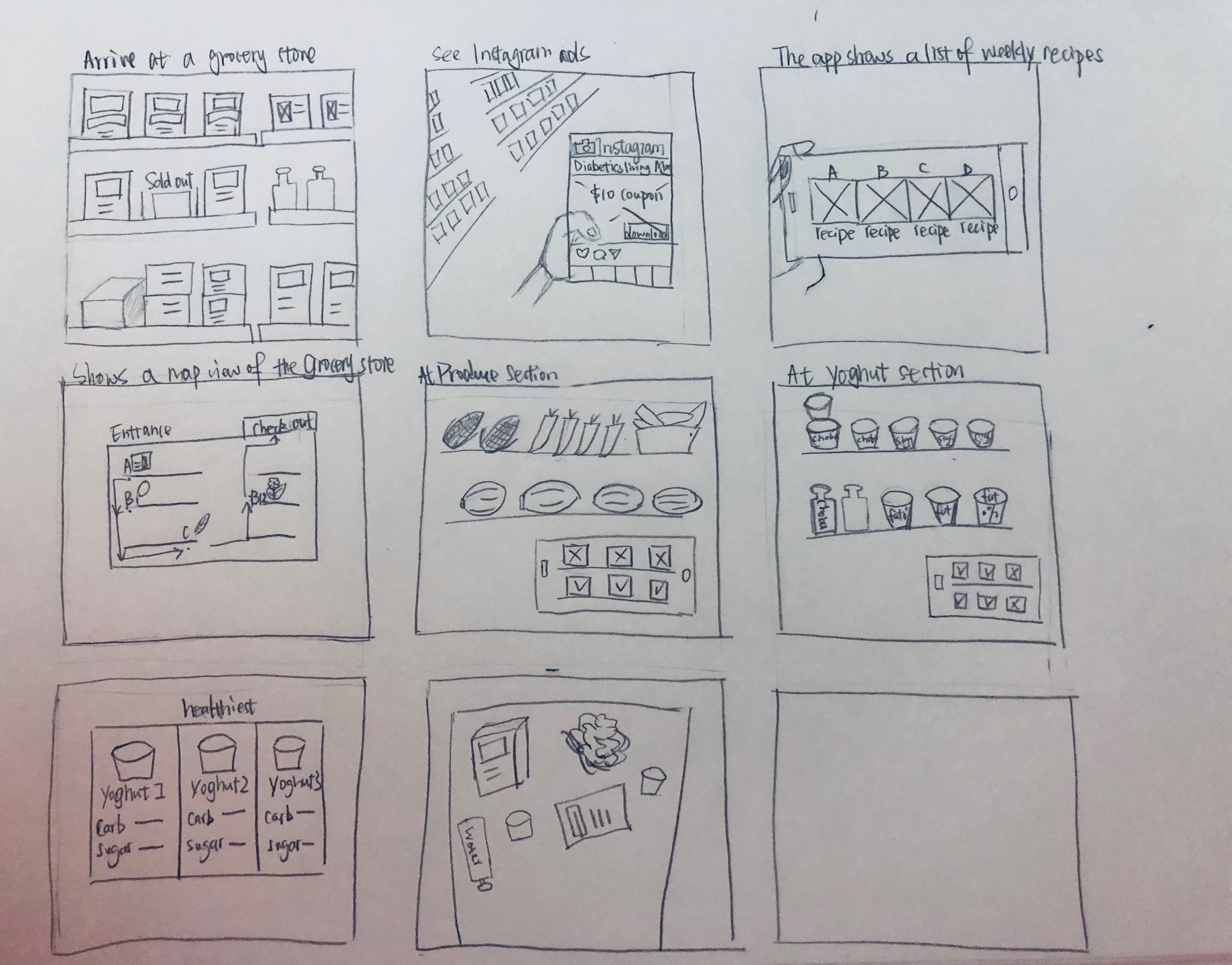How might we help Type 2 Diabetes (T2D) patients to make better food choices while grocery shopping?
Project Goals
PROJECT DETAILS
My teammate Yue and I have relatives with Type 2 Diabetes (T2D). We see their frustration and empathize with the hard time they’re having. T2D is a dreadful disease affecting hundreds of millions of people worldwide and is linked to and worsened by unhealthy lifestyles. We truly want to apply our knowledge to help them improve their health and achieve stable blood levels to make their lives easier.
Our goal is to help people who are suffering from T2D and empower them to live a healthy lifestyle.
Brimly is an augmented reality mobile app to help diabetics make better food choices at grocery stores. It helps T2D patients to quickly identify food options in a real time environment and choose the right product for them. This utilizes Augmented Reality and computer vision technology to enhance T2D patients' grocery shopping experience in a refreshing new way.
Collabortor: Yue Yuan from MFA Interaction Design SVA
My role: UX Designer, Interaction Designer, and Researcher
DESIGN
Design solution
Key Features
Diabetic Recipe Recommendations and Wayfinding: T2D patients can discover new food options through weekly diabetic recipe recommendations. Brimly simplifies the process of thinking about what to eat and where to buy the items. It syncs a collection of recipes for diabetics and shows a real-time map to direct their way at the grocery store.
Diabetic-Friendly Foods Recognition: In front of the produce section, T2D users hold the mobile app to scan. The app uses computer vision and objects recognition to show diabetic-friendly labels on healthy food items.
Food Comparison: T2D users can readily find out which food item works best for them, based on the key information that they most care about, after selecting multiple food items for comparison.
DISCOVER
Healthy eating is one of the most important methods to effectively manage and reduce the burden of diabetes. Diet directly influences T2D patients’ blood glucose levels, therefore increasing their healthy lifestyles, and helping them make better food choices that are significant to the patients’ well being.
“In general, I spend 30-45 mins doing shopping and spend 40% of time reading labels.
”
“An estimated 1.6 million deaths were directly caused by diabetes in 2015. ”
Problems
Frustration: It is time-consuming to read food labels to figure out key nutritional facts and calculate nutritional facts per serving.
Information Overload: It's hard for diabetics to choose one from multiple food choices. Besides key nutritional facts the diabetics care about, they also consider price, brand, flavor and more to meet personal needs.
Boredom: T2D patients are faced with an onslaught of restrictions and major lifestyle changes from the moment they are diagnosed. They are tired of eating basic food and want something new.
DEFINE
Affinity Mapping
Based on the user interview, I analyzed and synthesized the research data to find patterns and pain points.
Affinity mapping
Mapping out the current ways users interact with grocery stores
Persona
Based on 30 user interviews, I created two personas.
Newly diagnosed, Nicole, 46 years old
Type 1 Diabetes for Less than 5 months
Needs
- Find a more efficient way to read labels.
- Figure out what food to prepare, what should she avoid.
- Understand how much salt/sodium is in the product.
- Avoid the high sugar products she was eating before, instead of finding alternative ones.
- Find alternative snacks, and learn alternative names for sugar.
Long time diabetes sufferer, Ken, 56 years old
Type 2 Diabetes for 3 years+
Needs
- Spends less time in comparing food labels.
- Quickly finds low-carb food.
- Finds new products at grocery stores.
- Quickly figures out how much sugar per serving is in the food.
- Avoid buying food that contains chemical ingredients.
- Finds out the ingredients she doesn’t know, hard to pronounce, long name ingredients.
Storyboarding
Imagining how users would interact with the Brimly app at grocery stores.
Design Critique
"I think you should add AR and mobile as a value proposition to test. How / why does using the phone and visualization features bring value to the diabetic as she/he is grocery shopping? If diabetics are already using their phones in store, what are they doing? using google on their mobile browser? pulling up notes they've saved about food on their phone?"
-Amy Chen, NYC Media Lab Director
"Another risk hypothesis is that your app provides a service that is above and beyond other nutritional information apps. What makes your app stand out / what additional information are you providing that makes it a better resource for individuals with diabetes"
-Kate Danho
Evalution
For user testing, 30/30 diabetics say they want to use the Brimly app to get recommendations and help them save time on grocery shopping.
- Willingness to pay:
- 21/30 people are willing to pay for $1.99 - $5 to download the app
- 5/30 people are willing to pay for $10-$20 to download the app
- 1/30 people are willing to pay for $30 to download the app
- 3/30 people are not willing to pay for the app.

















